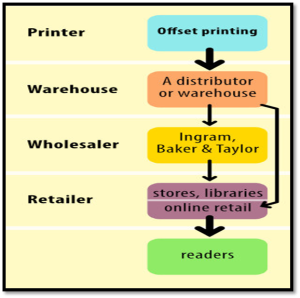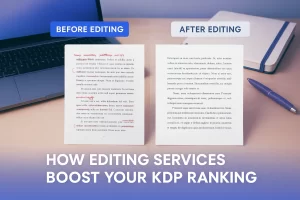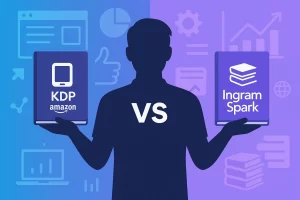Whether you are an emerging or established author or publisher running an independent publishing firm, you must have learn about the core publishing elements that help make your manuscript accessible to a wider audience. From the pre-production phase to the production process, the authors and designers meticulously work on enhancing the book cover and other visual components. The document is formatted and finalized for publication or digital production. The post-production phase is another crucial step in publishing for new authors and publishers, as it enhances the visibility of the author and their publication. Implementing a broad-based manuscript distribution strategy significantly helps in propagating a visually appealing and professionally formatted book to a wider audience. Leading book publishing services such has David McKay Publications have extensive distribution networks with online retailers, independent bookstores and dealers, academic libraries, e-libraries, and websites. They proactively manage the book publishing and distribution by connecting publishers with retailers, handling inventory, and managing logistics. Moreover, book distributors ensure that the author’s published and printed work is easily available to the public through traditional distribution channels and online publishing sites.
Common Book Distribution Challenges Faced by Inexperienced Authors
The transformation of the book distribution landscape poses new challenges for indie authors. It includes a lack of experience in market surveys, which makes it hard for novice authors to learn about the audience’s existing and changing trends. Since first-time authors and marketers have no idea of what the targeted readers want to read and their future expectations, they are unable to optimize their marketing and distribution strategies that resonate with readers’ interests and preferences. Consequently, it impacts book discoverability and global reach.
Another barrier that new authors face is establishing their market visibility in a highly competitive market. Due to market saturation, inexperienced authors are facing challenges in building their brand recognition.
Startup publishing companies and authors with limited marketing budgets and resources face trouble in boosting their in-store visibility to attract broad readers. Due to financial constraints, they struggle to choose appropriate distribution channels. Lack of significant knowledge of online publishing confines new authors from using different publishing platforms. Therefore, they utilize a single publishing platform that limits a book’s reach and distribution. In the absence of a strategic and proactive marketing and distribution plan, amateur publishers fail to promote books on online retailers and physical bookstores.
Having no sales history or experience in publishing makes it harder for self-publishing authors to get a major distributor to take on their published or printed books. Moreover, they face hassle in getting a valid ISBN, accurate metadata comprising title, author, price, and description. Authors using Amazon Exclusive face challenges, such as receiving damaged published books with issues like bent covers, broken spines, and dented pages. Inconsistent quality control and negligence in handling inventory adversely impact the brand image. Moreover, the high cost of printed copies, along with the frequent damage, increases the publishing cost and further causes hurdles in book marketing and dispatching books to libraries and many independent bookstores.
Another hassle for an unestablished writer is the difficulty in gaining high royalties. Due to a saturated market, a lack of audience engagement, and reduced online exposure, unknown authors receive smaller advances and a lower percentage of royalties.
Understanding Book Distribution
Print distribution
Choosing an Offset Printing Method
The print book distribution process involves authors choosing an appropriate printing method, preparing the manuscript for print, managing inventory, and dispersing the published books through a network of channels, including wholesalers, online retailers, and brick-and-mortar stores. Professional book publishing services use the offset printing method. It involves transferring digital files into images that are imprinted onto thin, flat metal plates. The visual image is then transferred from the plate to a flexible rubber blanket cylinder and then printed on the sheets. Once printing trims, the sheets are handled by printers for cutting, folding, binding, and lamination. The offset printing method is used by publishing houses for large print runs.

Print-on-Demand Services
The POD distribution model leads to fast and smooth digital and physical book distribution. The process involves authors uploading manuscripts to make single or bulk print and e-books as required by the clients. Print-on-demand mode streamlines distribution, such as managing the printing, packaging, and shipping of physical books to customers. Moreover, it promotes e-books and physical copies on global publishing platforms, reducing printing and inventory costs without bulk storage. An accessible and convenient publishing and book distribution model essentially helps indie authors and startup publishing companies to prevent low-risk printing and quick accessibility of books to the global e-book market.
Creating Distribution Channels with Retailers and Wholesalers
The publishers develop links and networks with local bookstores, retailers, and wholesalers to engage with wholesale distribution. They gather books at low rates and stock them in large warehouses. The retailers and wholesalers buy books in bulk at discounted rates from the publisher, and further retail the publication to bookstores, distribution networks, publishing firms, and libraries. In collaboration with bookstores, the publishers create online catalogs and marketing materials that promote books to a vast audience. Thus, distribution channels help publications get a favorable placement in physical and online stores and are sold at lucrative prices.
Digital Distribution
The digital book distribution process includes authors choosing distribution channels for direct distribution of books to prominent online retailing platforms. It implies that authors select the online platform as Kindle Direct Publishing (KDP), Draft2Digital, Apple Books, Kobo, and Google Play, and upload the file. As the book gets finalized for publishing, the online publishing service converts the file into a standard e-book, audiobook, and other digital formats. The aggregator and distributing network disseminates the digital publication to multiple retailers for massive book sales and high royalty payments. Through online distribution platforms, the digital book is listed for sale on the online storefronts. The readers conveniently access and purchase the book from websites and online bookstores.
Traditional vs. Self-Publishing Distribution
Traditional Book Distribution
How Traditional Publishing Houses Manage Distribution through Bookstores and Major Retailers
Traditional distributors oversee the entire process of printing to efficient storage, flow, and delivery of physical books to a vast audience. They ensure that a variety of print and e-books are accessible to buyers in both major chain stores and independent bookstores. So, if you are an inexperienced publisher and lack knowledge about print distribution. In such a case, you are required to seek professional assistance from prominent traditional publishing firms. David McKay Publications offers comprehensive publishing and distribution solutions to independent publishers and authors. Serving as a book distributor partner, the company manages the entire publishing process from manuscript formatting, design, to analyzing print and digital distribution. Manage inventory and shipping, and handle order processing and payments. With expert publishers, distributors, and wholesalers, the publishing house ensures that printed copies are quickly disseminated to buyers directly or via retailers, physical bookstores, and libraries.
The publishing experts build a robust network of distributors and retailers. Distributors act as intermediaries between publishers, customers, and distribution networks. The book distributor’s team includes book suppliers and book merchants, and the sales team. The wholesale unit facilitates publishers in managing logistics and inventory, and handling returns. A strong network of global distributors sells books to large chain stores, independent bookstores, and libraries, which leads to a faster delivery time and expanded market reach. With traditional book distributors ‘ assistance, the publishers get high sales points through physical bookstores and online platforms.
Direct-to-Consumer Book Sales
The process involves authors and publishers directly selling books to readers through traditional distributors’ support. Publishing house sends promotional emails to an extensive audience, offering preorder campaigns, discounts, and promotions. Using a direct-to-consumer sales strategy also incentivizes customers with limited discounted editions, complimentary reading of initial chapters, and early-bird pricing. Consequently, the buyers are encouraged by publishers to provide their feedback on the website. The consumer’s data related to reading preferences and purchasing habits allows publishers to develop more effective digital book distribution strategies that engage the target audience. It includes distribution strategies for SEO, social media, and leveraging paid advertising that boost organic traffic and bring high conversions, and increase profit margins.
Traditional Publishers Guide New Authors about Market Intelligence
Another distribution service offered by the David McKay company is facilitating new publishers with market intelligence and keeping them updated with market trends, demographics, reading choices, and preferences. Analyzing purchasing patterns allows authors to evaluate their sales targets and assess the overall market size, and learn about tapping into new markets to gain more visibility.
Amazon Book Publishing Services
David McKay Publications offers comprehensive Amazon book publishing services to self-publishing authors. Experienced Amazon publishing team guides new authors with book editing, cover design, and layout and book formatting based on Kindle and print standards. Amazon’s publishing team competently handles everything, from file export to formatting into print and e-book, manuscript submission final publishing process. Amazon’s marketing strategy involves authors employing keyword optimization, titles, metadata descriptions, high-quality images, and competitive pricing to increase manuscript visibility among a global audience. A vast Amazon online marketplace provides a global platform to authors for making smooth and rapid distribution and sales of print and digital books worldwide.
The Publisher’s Role in Pitching to Independent Bookstores
Traditional distributors present their work to local retailers, independent bookstores, and libraries to increase marketing and distribution. The sales and marketing teams collaborate and develop a wide-ranging sales and distribution strategy. It includes letting consumers know about upcoming titles, their genres, prices, and other publishing details. The book distributors and bookstores use catalogs and promotional materials to entice online readers to make preorders through landing pages, or online publishing sites, and approach physical bookstores to purchase their copy.
The publishers organize trade shows and book launching events such as author signings, book clubs, book exhibitions, podcasts, and Q/A sessions. These promotional events help readers get introduced to new authors and publishers, boost book sales, and also build up a distribution network.
A team of retailers, wholesalers, and independent publishers collaborates with online retailers to promote books on online marketplaces. The online retailer sites, such as Amazon or Bookshop, create online book pages, set appropriate pricing, and offer promotional giveaways, wholesale discounts, and organize seasonal events that attract online buyers. These promotional incentives increase book visibility, boost distribution, and bring high markup profit.
How Traditional Publishers Assist in the ISBN Process
If you are an experienced author or publisher associated with book writing services, you do not need to purchase an ISBN for your published book. A traditional publishing house is responsible for acquiring the ISBN. The publisher registers the book and its metadata with the author’s details. They obtain ISBNs in bulk. A separate ISBN is assigned to the author’s book for each format, including hardcover, paperback, and e-book. The publisher handles all aspects of ISBN management, including the registration of the published book. They provide manuscript details such as description, cover image, and other book specifics under their name.
Obtaining a specific book identification code is essential for classifying books for booksellers, libraries, and distributors worldwide. Furthermore, it also helps in manuscript discoverability on Amazon and other online publishing platforms.
Self-Publishing Distribution
Suppose you are an experienced self-publishing author and have competently handled book production, design, marketing, and publishing tasks. However, self-book distribution appears to be daunting for you, as you have to manage all aspects of manuscript distribution, including online and physical retailing, warehouse and logistics expenses, and building a distribution network for the prompt delivery of books to different regions and locations.
If you lack experience in managing self-book distribution, you have a lucrative option to get connected to online publishing platforms. Initially, you are required to choose an appropriate publishing platform such as Kindle Direct Publishing (KDP), Draft2Digital, Smashwords, and IngramSpark. Here, you don’t have to handle everything by yourself. Just upload your books to platforms. They provide numerous templates and tools to format your book for either digital or print publication. To create a digital form of the manuscript, the authors use platforms like Draft2Digital or KDP to export the file into an ePub format. They adopt a multi-channel approach for marketing and distribution of digital and print versions. It includes the author’s website, social media, and a wide array of digital retailers, including Amazon (Kindle), Apple Books, Kobo, and Google Play Books.
Additionally, self-publishers also create, market, and distribute audiobooks using various platforms. The Audible platform is a leading platform for purchasing audiobooks. Audiobook Creation Exchange connects authors and publishers with narrators to develop high-quality audiobooks. Findaway Voices is a service aggregator company that signs contracts with independent authors and publishers to market and distribute audiobooks to retailers such as Audible, Apple Books, OverDrive, and Kobo.
Well-structured and polished e-books and audiobooks reach various online distribution sites, including e-book stores and audiobook retailers within hours. The publications are also available in an online library. Working in collaboration with online retailers and distributors increases book sales and helps self-publishers earn high royalty rates.
Global Distribution
Many new publishers plan to expand their book distribution reach; therefore, the best option for them is to tap into the new publishing markets across the globe. To make their books discoverable for a global audience implies that the publishers get connected with professional book publishing services. They have numerous book distribution channels, such as independent bookstores, online stores, e-book retailers, and libraries, that ensure that both print and digital publications are easily accessible to online readers and buyers.
The other option for self-publishers is using online publishing and distribution services such as Amazon KDP, Barnes & Noble, Google Play, and Kobo. They offer print-on-demand services that involve both publishing and printing of e-books, paperbacks, and hardcovers. The publishers create a single copy or publish books in bulk as required by the client. In a couple of hours, the books are dispatched to online customers.
Global distribution enhances the author’s online presence and makes their work visible to international literary communities. As though in the beginning, independent authors and publishers encounter difficulties related to managing international logistics and high shipping costs. Working with several international distributors and retailers leads to market complexity and brings lower profit margins. As publishers successfully compete in the foreign book markets, it opens new opportunities for publishers to work in collaboration with foreign book publishing services. It includes creating manuscript translations, film or television adaptations, creating video book trailers, and other digital formats. It significantly increases the potential readership and upsurges sales volume.
How Publishers Maximize Their Distribution Strategy
Let’s suppose you have recently published your manuscript and intend to distribute your e-books and printed versions in the local and international book market. You can adopt key distribution approaches.
Hybrid Approach: Combining direct sales + online retailers + aggregators
Leading publishing houses such as David McKay Publication adopt an inclusive marketing and distribution approach. It includes following a hybrid distribution and sales approach. The strategy allows the publishing house to use its direct-to-consumer (DTC) channel with online retailers and third-party aggregators to expand its distribution reach. Partnering with online retailers and third-party aggregators helps publishers to exercise their autonomy and control over book distribution and sales in online marketplaces.
Metadata Optimization: ISBN, Keywords, Categories, Cover Design
Another initiative to boost the online visibility of books is using Metadata description and keywords strategy. The SEO marketers in professional book writing services create compelling metadata descriptions, titles, and categories that introduce a book and the author to new readers. Moreover, generating relevant and appropriate keywords makes it easier for buyers to search for the required book on Amazon and Google. Consequently, it helps boost a published book’s discoverability on the Google search engine. As more readers search algorithms, it increases organic traffic, brings high conversion, and better author and book visibility.
Pricing Strategies: Competitive Pricing, Promotions, and Discounts
Self-publishers use strategic pricing to increase manuscript distribution through physical retailers and online book stores. The published books with lower prices attract a diverse audience and influence their purchasing capacity. Lower price points, along with other incentives such as pre-release price, preorders, limited-time promotion, and launch pricing for both e-books, paperback, and hardcovers, appeal to different consumer buying trends and increase sales.
Author Branding: Building Credibility to Make Distribution More Effective
By building an author’s website, the author showcases their writing and publishing expertise. The landing page includes the author’s bio along with a listing of new and past publishing works that make new readers familiar with the writer’s published works. The website provides a direct channel to promote and sell the author’s work. Online readers directly search for the required published book on the website; the contact details and email help readers know the online purchasing process. Or they search the link to social media to purchase the book. The landing page keeps the audience updated on new releases, prices, discounts, and promotions.
Integrate Marketing with Distribution
It implies professional book publishing services to optimize their book marketing and distribution strategy since the pre-launch phase. Marketing campaigns are launched on the website, social media, and online advertising and sales channels. The distributors are required to select early retailers that keep the audience and social media followers informed about the pre-order and online purchasing process. To boost marketing and distribution on Amazon, the marketers ensure that metadata description is finalized on all online retail sites before the book launch. Once the book is released, the publishing house gets involved with post-book launch activities. It includes hosting book signings, live reading sessions, a podcast and Q&A session, book exhibition, and organizing virtual book tours. Moreover, partnering with influencers such as BookTok entices readers by creating short and striking video book trailers and animated illustrations that capture the audience’s attention and increase book distribution and sales. The ad campaign, such as Amazon Ads, Facebook Ads, or Google Ads, offers promotional giveaways and incentives that hook potential audience to acquire their personal copy.
Monitor Sales and Adjust Strategy
The book distribution team needs to monitor the manuscript sales volume in real-time. It includes tracking sales performance, analyzing the key metrics such as sales revenue, customer acquisition cost, and appropriate pricing. Reviewing customer feedback posted on websites and social media channels helps publishers align their market dynamics and distribution strategy and make informed changes in their sales strategy. It includes developing more compelling promotional tactics for companies to maximize book reach. Revising pricing strategy to attract a wider audience. Streamlining distribution networks helps improve the sales process and enhance book discoverability in the global book market.
To Recapitulate
Whether you are a traditional book publisher or an independent, you must know that manuscript distribution is not a one-size-fits-all solution, as the distribution strategy is determined by a variety of factors. It includes the author’s goals of either searching merely the local book market or seeking global exposure to boost mass marketing and distribution. Book distribution strategy involves authors analyzing the targeted audience’s buying preferences and trends. Whether the potential customers prefer purchasing books from physical bookstores or through online publishing sites. Gaining demographic knowledge helps publishers to choose a hybrid book distribution approach that integrates traditional and digital publishing channels. It includes Offset printing and online retailing through Amazon (KDP), Apple Books, Barnes & Noble, and Kobo. Traditional publishers establish relationships with retailers, dealers, and online bookstores and sell their printed and digital format books at a low rate. The published manuscripts are further dispatched to a global audience through independent bookstores and e-bookstores. The other factors include opting for an appropriate book format, such as print books or e-books, and managing logistics and shipping costs. Self-publish authors prefer marketing and distribution through online publishing channels to gain high book discoverability maximizes profit.
Since book distribution is a significant part of publishing strategy, both traditional and self-publishers integrate marketing and distribution plans. It includes initiating direct sales through the author’s website, online stores, a physical brick-and-mortar location, email marketing campaign, and social media marketing channels. Organizing book launch events also propagates published books to new and existing readers. Direct sales approach offers the highest profit margin and boosts reader engagement. Startup publishing companies and self–published authors can promote book sales through paid advertising such as Facebook ads, Amazon ads, and Google ads. The striking ads with promotional incentives such as price drops, pre-orders, and giveaways entice buyers to purchase e-books, audiobooks, or printed publications. Leading publishing houses including David McKay Publications ensure that e-published books and printed manuscripts are distributed in the local and international book market through extensive distribution networks. The optimal author’s distribution strategy increases book discoverability in physical bookstores and online marketplaces. Hence, it ensures a wider market reach and drives high sales and maximum profit.




